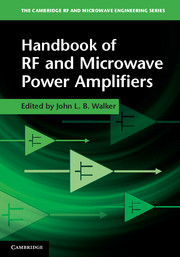Book contents
- Frontmatter
- Contents
- Contributors
- Preface
- 1 Silicon LDMOS and VDMOS transistors
- 2 GaAs FETs – physics, design, and models
- 3 Wide band gap transistors – SiC and GaN – physics, design and models
- 4 Amplifier classes, A to S
- 5 Computer-aided design of power amplifiers
- 6 Practical HF/VHF/UHF RF power amplifier realization
- 7 Microwave hybrid amplifier realization
- 8 Monolithic power amplifiers
- 9 RF power amplifier thermal design
- 10 Reliability
- 11 Power amplifier applications
- 12 Amplifier measurements
- About the authors
- Index
- References
10 - Reliability
Published online by Cambridge University Press: 05 November 2011
- Frontmatter
- Contents
- Contributors
- Preface
- 1 Silicon LDMOS and VDMOS transistors
- 2 GaAs FETs – physics, design, and models
- 3 Wide band gap transistors – SiC and GaN – physics, design and models
- 4 Amplifier classes, A to S
- 5 Computer-aided design of power amplifiers
- 6 Practical HF/VHF/UHF RF power amplifier realization
- 7 Microwave hybrid amplifier realization
- 8 Monolithic power amplifiers
- 9 RF power amplifier thermal design
- 10 Reliability
- 11 Power amplifier applications
- 12 Amplifier measurements
- About the authors
- Index
- References
Summary
Introduction
This chapter provides an overview of basic reliability theories and presents some example data to illustrate concepts. The three key reliability precepts of understanding failure mechanisms, failure distributions, and acceleration factors are discussed in detail. Various reliability test methodologies and results are presented with respect to device processing and circuit elements that are likely to be included in amplifying devices. Some differences between compound semiconductor and silicon technology are covered from a reliability point of view. Additional reliability aspects of fabrication, application, and design are also discussed. It is hoped that the information presented here provides the basis for establishing reliable radio frequency power amplifiers.
Reliability is as much a key to success in the microelectronics industry as is performance. Not only must a product perform as desired, it must work for years without fail. It does little good to make the world's highest efficiency amplifier if after two weeks of operation it fails. With the complexity of today's microelectronics, a phenomenal level of reliability must be maintained. For instance, if the probability of failure for a transistor is one in a million, and you have a million transistors in a circuit, the probability of failure is nearly certain. And yet, a modern microprocessor or memory circuit can have more than 10 million circuit elements. Therefore, for any acceptable reliability on the chip level, today's circuit elements must be among the most reliable things ever built. In addition, reliability must continue to increase as the complexity increases and as performance improves.
- Type
- Chapter
- Information
- Handbook of RF and Microwave Power Amplifiers , pp. 446 - 507Publisher: Cambridge University PressPrint publication year: 2011



